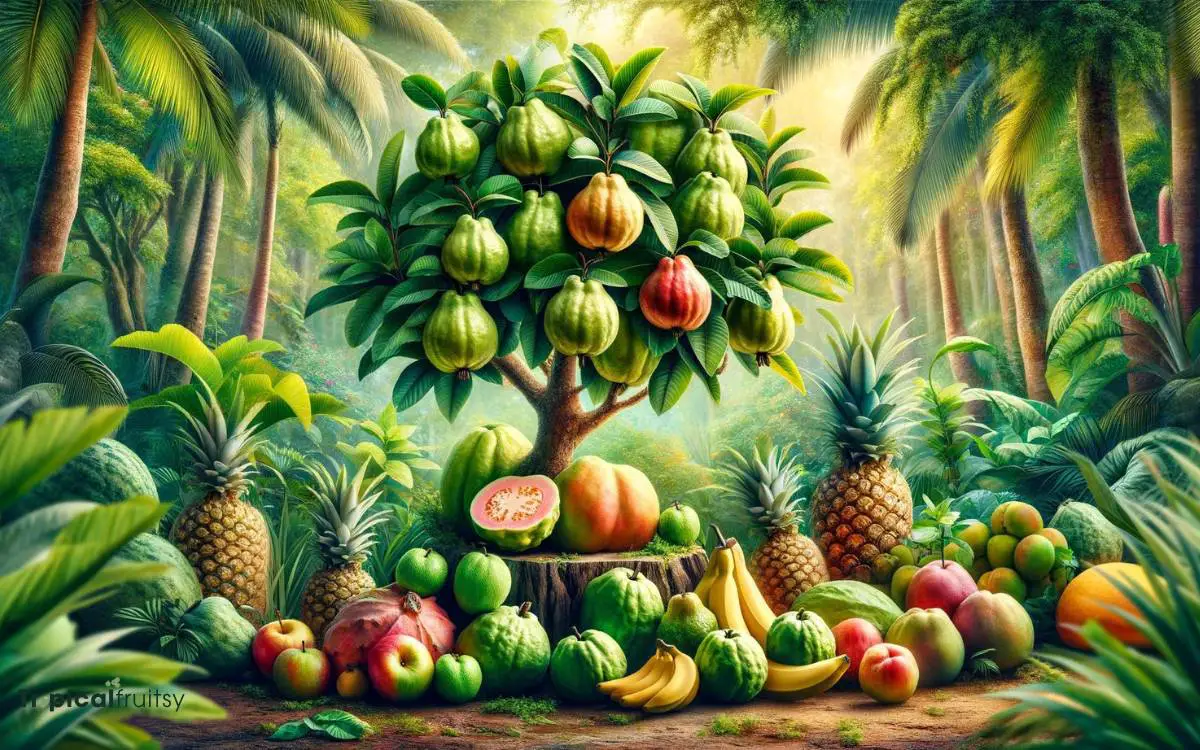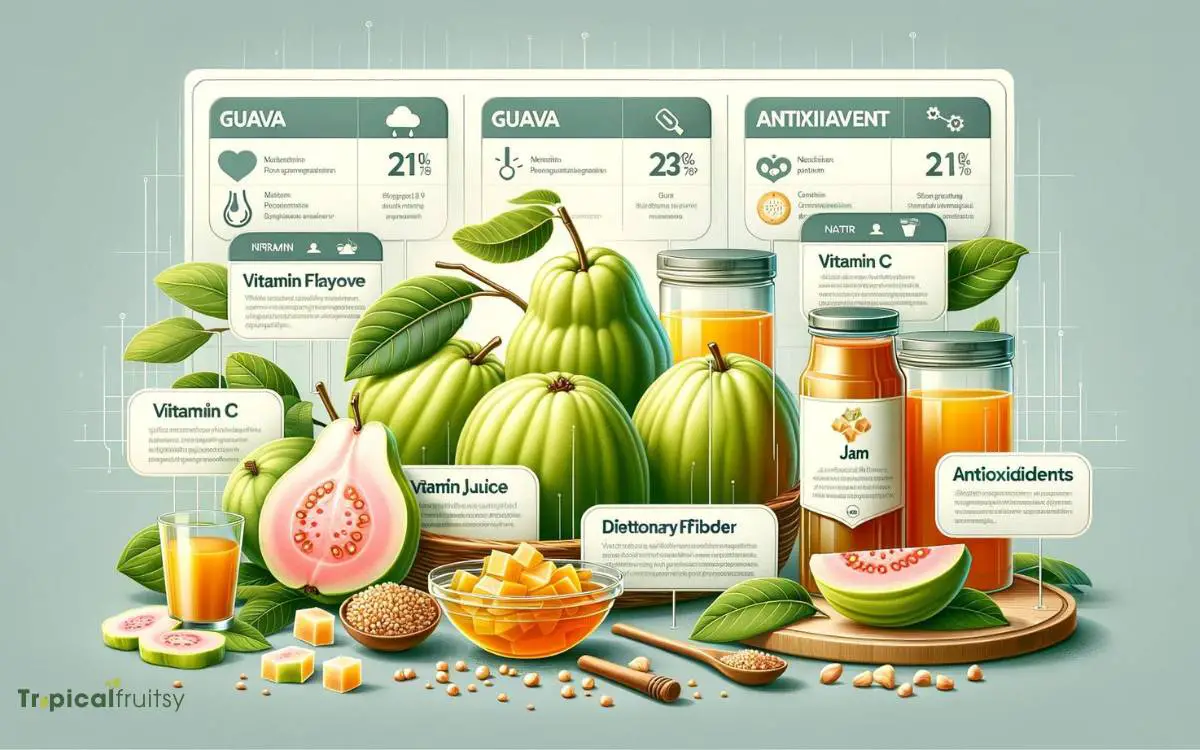Is Guava a Tropical Fruit? Explore!
Guava is a tropical fruit known for its distinctive flavor and health benefits. Originating from tropical regions, it’s a staple in many cultures’ diets.
Guava is classified as a tropical fruit because it grows predominantly in warm climates. It is part of the Myrtaceae family, under the genus Psidium.
This fruit is easily recognizable by its green to yellow skin, with pink or white flesh inside. Guava is not only enjoyed for its taste but also for its nutritional benefits, as it is packed with vitamins and minerals.
Packed with flavor and nutrition, guava is a versatile tropical delight enriching diverse culinary traditions.

Key Takeaway
10 Nutrient: Content in 100g of Guava
| Nutrient | Content in 100g of Guava |
|---|---|
| Energy | 68 kcal |
| Protein | 2.55 g |
| Total Fat | 0.95 g |
| Carbohydrate | 14.32 g |
| Dietary Fiber | 5.4 g |
| Sugars | 8.92 g |
| Vitamin C | 228.3 mg |
| Vitamin A | 624 IU |
| Calcium | 18 mg |
| Iron | 0.26 mg |
Unveiling the Guava’s Origins

Originating from Central America, the guava is indeed a tropical fruit that has spread across various regions of the world.
Psidium guajava, the common guava, is a species of the Myrtaceae family and thrives in tropical and subtropical climates.
Its prevalence in Central America is attributed to the region’s conducive environmental conditions, characterized by warm temperatures and well-distributed rainfall patterns.
The guava’s propagation beyond its endemic range is largely due to human cultivation and the adaptability of the species to diverse ecological niches.
Botanical evidence suggests that the distribution of guava was facilitated by its desirability as a food source, leading to its intentional dissemination through trade routes and exploration.
Consequently, guava has become naturalized in many parts of Asia, Africa, and the Pacific Islands.
Guava’s Preferred Climate

The guava predominantly flourishes in tropical climates where temperatures remain consistently warm and humidity levels are high, providing the ideal conditions for its growth and fruit production.
This perennial plant thrives in regions where the mean annual temperature ranges from 23 to 28 degrees Celsius, and where relative humidity oscillates between 60% and 80%.
Guava plants are highly sensitive to frost, which can lead to cellular damage and inhibit enzymatic activity critical for metabolic processes.
Optimal rainfall for guava cultivation is typically between 1000 to 2000 millimeters annually, preferably spread throughout the year to avoid periods of water stress that can adversely affect yield and fruit quality.
These climatic prerequisites underscore the species’ proclivity towards equatorial and subequatorial zones where such environmental parameters are met with consistency.
Nutritional Profile of Guava

Guava’s adaptation to warm, humid climates not only influences its cultivation but also contributes to its rich nutritional profile, which includes high levels of vitamin C, dietary fiber, and antioxidants.
A detailed analysis of this fruit reveals that it is an exceptional source of ascorbic acid, with a single guava providing more than the daily recommended intake of vitamin C, which is pivotal for immune function and skin health.
Furthermore, guava is replete with dietary fiber, crucial for maintaining digestive health.
Its composition is further enhanced by a spectrum of antioxidants, including lycopene and beta-carotene, which are implicated in the neutralization of free radicals and may confer protective effects against oxidative stress.
The fusion of these nutrients makes guava a valuable dietary inclusion, leading to its diverse culinary uses worldwide.
Culinary Uses Worldwide

Numerous cuisines globally incorporate guava, utilizing its unique flavor and nutritional benefits in a variety of dishes ranging from sweet to savory.
The fruit is esteemed for its high vitamin C content, dietary fiber, and potent antioxidants. Its culinary applications are diverse, reflecting its widespread cultivation in various tropical and subtropical regions.
- Jams and Jellies: Guava’s pectin-rich flesh is ideal for creating thick, spreadable preserves.
- Desserts: Pureed or diced guava is often incorporated into pastries, mousses, and ice creams.
- Beverages: Guava juice and smoothies are consumed for their refreshing taste and nutritional properties.
- Sauces and Marinades: Guava paste or reduction imparts a sweet-tart flavor to meats and seafood.
- Salads: Fresh guava slices add a tropical note to green and fruit salads.
This versatility in preparation methods demonstrates guava’s adaptability to different culinary practices.
Understanding the procedures for proper cultivation is fundamental for those aspiring to include fresh guava in their cooking repertoire, which leads us to the subsequent section about ‘cultivating guava at home’.
Cultivating Guava at Home

Often, enthusiasts of tropical fruits like guava seek to cultivate their own plants at home, a process that requires understanding specific horticultural needs to ensure a successful harvest.
The Psidium guajava, commonly known as guava, necessitates well-drained soil with a pH between 5.5 and 7.0 for optimal growth.
Adequate sunlight exposure and temperature regulation are pivotal, as guava plants thrive in full sun and temperatures ranging from 68 to 82 degrees Fahrenheit.
To elucidate, consider the following table articulating crucial cultivation parameters:
| Factor | Requirement |
|---|---|
| Soil Type | Loamy, well-drained |
| pH Range | 5.5 to 7.0 |
| Light Exposure | Full sun |
| Temperature | 68°F to 82°F (20°C to 28°C) |
These parameters must be meticulously monitored and adjusted to maintain an environment conducive to the guava’s tropical origins.
Conclusion
The guava emerges as a quintessential tropical fruit, thriving in warm, humid climates, and offering a rich tapestry of nutrients. Its global culinary applications reflect a versatility that transcends cultural boundaries.
While home cultivation presents challenges, it mirrors the resilience and adaptability of the fruit itself.
The juxtaposition of guava’s robustness in the face of climatic demands against its delicate flavor profile underscores the complexity inherent in this botanical phenomenon.






